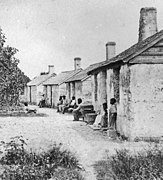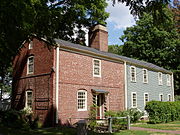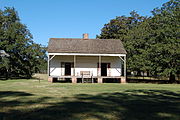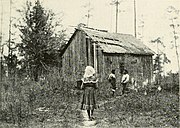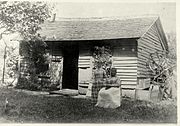Slave quarters in the United States
Slave quarters in the United States, sometimes called slave cabins, were a form of residential
Rural slave quarters
Context
Plantation slavery had regional variations dependent on which cash crop was grown, most commonly cotton, hemp, indigo, rice, sugar, or tobacco.[3] Sugar work was exceptionally dangerous—the sugar district of Louisiana was the only region of the United States that saw consistent population declines, despite constant imports of new slaves.[4][3] The cotton plantations used the grueling gang system.[3] Some plantations used the task system, which permitted slightly more leisure time and thus development of domestic life amongst the enslaved.[3] As a rule, personal freedom for slaves was restricted to what could be achieved in the slave quarters from sundown to sunup.[5]
On some farms, slave houses were part of a larger, centrally located community group. For example, at
Field cabins
Field cabins were isolated and somewhat remote but offered agricultural workers close proximity to crop fields.[2] Few field cabins survive as they were generally "left to rot" after the last residents departed.[2][8]
Architecture and material culture
Rural slave quarters were usually one or two-room cabins occupied by a family unit.
On average, slave quarters were
Bedding was usually either straw on the floor or a straw-filled tick with a thin blanket.[14] Bedframes were uncommon; where they existed, they were constructed with cord.[13] Bureaus, tables, and chairs were uncommon.[14] Possessions of cultural significance included homemade musical instruments such as drums and fiddles fashioned from dried gourds.[14] Household goods in slave quarters were minimal but might have included work tools, iron cookware, pewter spoons,[15] and locally made pottery (colonoware).[14]
The slave quarters often developed independent systems for food and cloth production. Enslaved adults on a plantation were provided with specific food rations and clothing allotments but these were typically inadequate, so the slave quarters were a place where preparations were made for
Many slave quarters also hosted burial grounds for the dead.[17] Burials in slave cemeteries were often poorly marked even when in active use (carved stone grave markers would have been impossibly expensive), and over the decades and centuries essentially disappeared into the landscape even when they were not actively erased.[18][19] As one reporter wrote upon visiting the ruins of Prospect Hill in Mississippi: "No one yet knows where the slaves are buried, their wooden markers long since having crumbled into dust."[20]
Urban slave quarters

Lacking the self-limiting isolation of the plantation, urban slave quarters nonetheless existed within a system designed to preclude insurrection and protect the race-caste system that underpinned the municipal economy.[21] Urban slave quarters ranged from in quality from sturdy masonry barracks to rickety wooden shacks.[21] Observers of urban compounds in Wilmington, North Carolina and Charleston, South Carolina noted that the slave quarters were typically at the back of the property, adjacent to a work yard, all surrounded by barrier walls. High walls were particularly common toward the rear property line and were likely intended to limit unsupervised entrance and egress by the enslaved.[21] Urban slave quarters were often mixed-use blocks that combined residential space for the enslaved with laundries, privies, stables and similar workspaces.[21] In 19th century Charleston a typical arrangement would be a first floor with a laundry room and a kitchen, each with separate fires and chimneys, separated by a central stairway leading up to slave residences on the second floor.[22] In other cases the upstairs living space was set above a carriage house or a shop.[22] Many urban slave quarters were preserved after Emancipation because they served as still-useful servants' quarters, guest quarters, store rooms, etc.[2]
The Encyclopedia of Louisville (2014) described slave quarters in the border-state city: "Generally, urban slaves' quarters were connected to their owners' property, usually in 'servant's rooms.' A typical newspaper ad from this period described a brick house for sale as having eleven rooms, two passages, a large kitchen, three servants' rooms, and a washhouse. Sometimes advertisements of this nature made it clear that the servants' rooms were in an outbuilding. In most cases, outbuildings were located behind the main house, on the alley. This is significant when coupled with the fact that most city lots, as evidenced by newspaper ads, were long and narrow. Thus, the white population was housed on the street side while their servants were relegated to the alley side of city lots."[23]
"Free state" slave quarters
Slave quarters existed in northern states (in what would become the
Scholarship and preservation
Former slave quarters are valuable resources for archaeologists studying daily life under slavery and expressions of cultural identity amongst the enslaved.[12]
The still-extant
There is significant variation in how historic sites interpret former slave quarters for visitors.[24][27][28]
Additional images
-
Building said to be "old slave quarters" Appleby Library, Augusta-Richmond County Public Library System
-
Front view of "old slave house" at Strawberry Hill Plantation, Forkland, Alabama
-
Beacon Tower and "negro cabin", Cockspur Island, Georgia, photographed 1863
-
Slave quarters at Tuckahoe Plantation, Virginia, photographed 1914
-
Slave quarters of theOwens-Thomas House, Savannah, Georgia
-
Slave quarters made oftabby concrete, Kingsley Plantation, Fort George Island, Florida, photographed 1865
-
Royall House slave quarters in Massachusetts, constructed 1732
-
"Row of Negro Cabins", Destrehan, Louisiana, photographed 1938
-
Bolling Island Plantation, Goochland, Virginia
-
"Colored People's Schoolhouse", nearSuwanee River, photographed 1904
-
Slave cabin atBoone Hall Plantation, Mount Pleasant, South Carolina
-
Slave cabin, location unknown
-
Slave quarters at Felix Vallé House State Historic Site, Ste. Genevieve, Missouri
See also
- List of slave cabins and quarters § United States
- Slave pen
- List of slave owners
- Treatment of slaves in the United States
- Female slavery in the United States
- Invisible churches
- Praise house
- Pan toting
- Chesapeake pipes
- Face jugs § America
References
- ^ "Archaeological Collections in Maryland, Sotterley Slave Cabin". apps.jefpat.maryland.gov. Retrieved 2023-02-18.
- ^ S2CID 164554921.
- ^ a b c d e f g h i Young, Amy L.; Hudson, Blaine J. "Slave Life at Oxmoor" (PDF). Folsom Club Historical Quarterly.
- ^ S2CID 41631256.
- ^ JSTOR 25163462.
- S2CID 165206902.
- . Retrieved 2023-08-25.
- ^ a b Kennedy, Rachel; Macintire, William (1999). "AGRICULTURAL AND DOMESTIC OUTBUILDINGS IN CENTRAL AND WESTERN KENTUCKY, 1800-1865" (PDF). Kentucky Historic Preservation Office.
- ^ JSTOR 40713143.
- ^ Owens, Sheldon Ben (2009). The Dogtrot House Type in Georgia: A History and Evolution (PDF) (Master's of Historic Preservation thesis). Athens, Georgia: University of Georgia.
- ^ JSTOR 29764375.
- ^ JSTOR 2155932.
- ^ a b c Imbler, Sabrina (February 26, 2020). "Meet the Iowa Architect Documenting Every Slave House Still Standing - Atlas Obscura". Atlas Obscura. Retrieved 2023-02-18.
- ^ JSTOR 29763792.
- S2CID 189846550.
- JSTOR 27650401.
- ^ Katz, Brigit (March 15, 2018). "A Slave Cemetery May Have Been Discovered at a Plantation Near Annapolis". Smithsonian Magazine. Retrieved 2023-02-18.
- ProQuest 2313107830.
This, the Beckers told them, is where the enslaved Kings are probably buried in unmarked graves. Oak and walnut trees dotted the area, which was smothered below with brush, poison ivy and wild rose hips. Growing up, Amanda told the Kings, she'd play by herself along the path and hold tea parties. When she and her sister got older, they'd venture into the bushy area and look for headstones. 'Nobody ever stumbled on a headstone?' Melissa asked. She tapped her neck with her finger over and over, while John rubbed his chin. The Beckers said they'd been told that their grandfather Vestus Wilcox, a lieutenant commander in the Navy, tossed the missing headstones over a hill somewhere. But they didn't know for sure. The Kings asked, is it possible to conduct a search? Amanda said she and her husband were exploring the possibility of purchasing radar equipment. 'It'll be detective work,' Frances said. 'We can find it.'
- .
- ^ "'This is surreal': descendants of slaves and slaveowners meet on US plantation | Mississippi | The Guardian". amp.theguardian.com. Retrieved 2023-09-08.
- ^ S2CID 161633485.
- ^ S2CID 163361380.
- Project MUSE book 37208.
- ^ S2CID 162729250.
- ^ Fidurski, William. "Homestead Farm at Oak Ridge Application to National Register of Historic Places". nps.gov. Retrieved 2024-01-17.
- ^ American Place: The Historic American Buildings Survey at Seventy-five Years (PDF). U.S. Department of the Interior Museum. 2008.
- ^ Biser, Margaret (August 28, 2017). "I used to lead tours at a plantation. You won't believe the questions I got about slavery". www.vox.com. Retrieved 2023-02-18.
- ISSN 0882-7729. Retrieved 2023-02-18.
Further reading
- Eichstedt, Jennifer L.; Small, Stephen (2002). Representations of slavery : race and ideology in southern plantation museums. Washington. )
- Singleton, Theresa A. (1995). "The Archaeology of Slavery in North America". Annual Review of Anthropology. 24: 119–140. JSTOR 2155932.
External links
- Encyclopedia Virginia: Housing for the Enslaved in Virginia
- Simkin, John (2014). "American History > Slavery > Slave Housing". Spartacus Educational.







